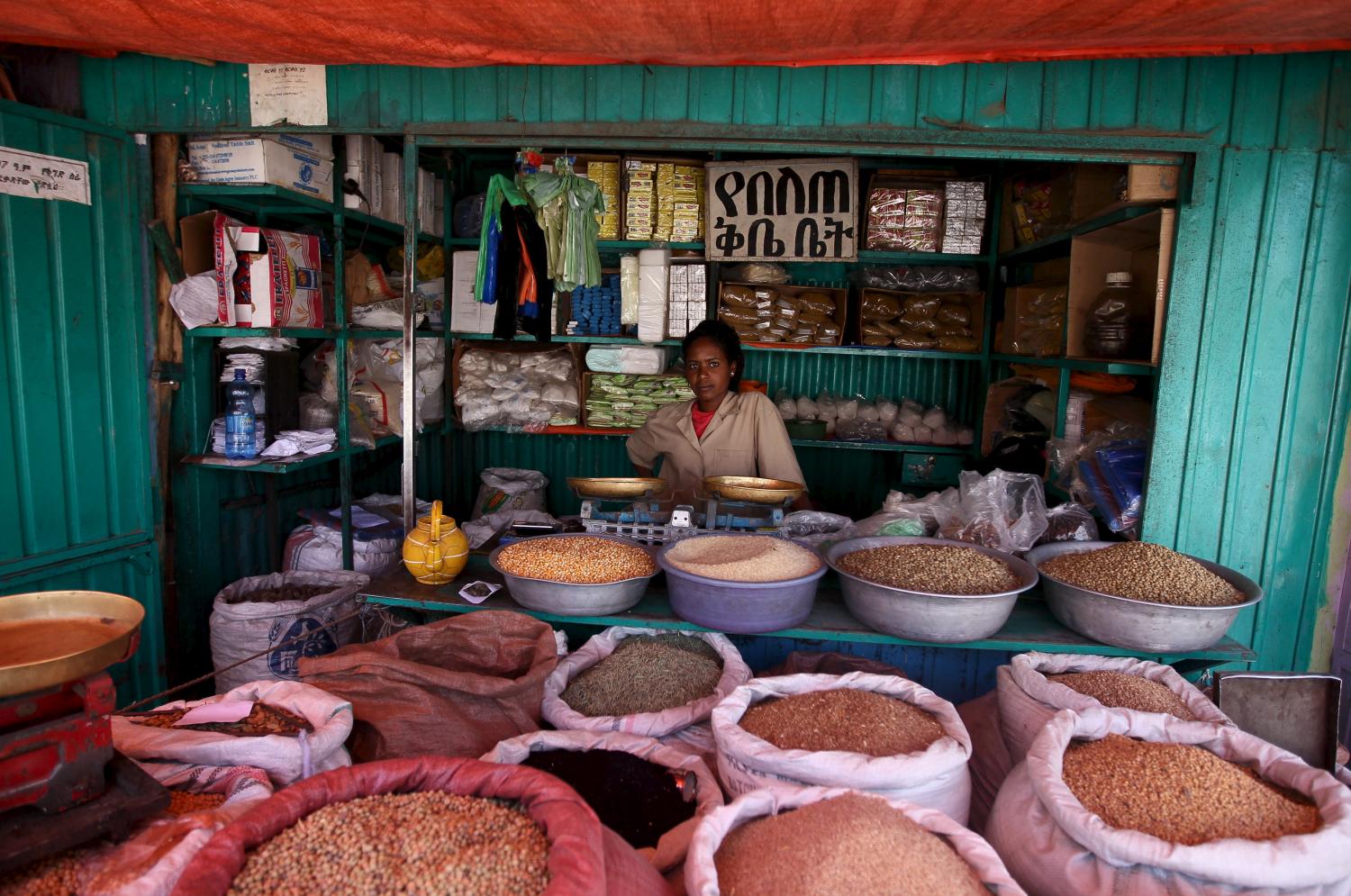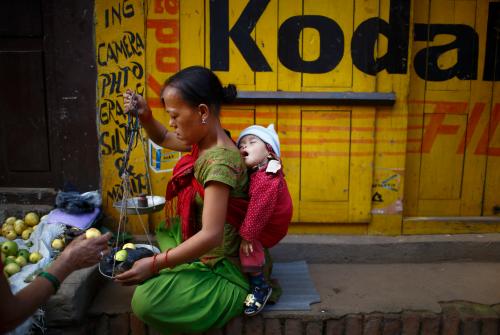Introduction
Around the globe, women participate less in paid economic activities than men. The gender gap in labor force participation is around 14 percent in the median OECD country, 26 percent in the median middle-income country, and 13 percent in the median low-income country.1 When women do participate, they are often conscribed to different, lower-paying jobs and sectors. This is true whether we focus on wage jobs, on farming, or on entrepreneurship. These gender gaps come at a substantial economic cost, ranging from an average income loss of 10 percent in Central Asia to 38 percent in the Middle East and North Africa.2
A growing number of papers argue that increasing women’s economic opportunities and leveling the playing field between men and women is good for aggregate economic growth and good for development.3 In line with these arguments, governments in many countries, of different income levels, are looking for effective ways to increase women’s participation in the economy and support women’s economic empowerment. Often, and especially in middle- and lower-income countries, they look to entrepreneurship programs as a way around the lack of good jobs for women, and men for that matter. Entrepreneurship programs come in many forms—they vary by type and duration of intervention, target group, delivery mechanisms. And their effects are, perhaps not surprisingly, equally heterogeneous.
In a recent meta-review of entrepreneurship programs in developing countries, Cho and Honorati (2014) conclude that programs vary widely in effectiveness by target group (better for youth than for women or other subgroups); type of outcome (better for business knowledge and practice but with little effect on business expansion or incomes); and type of intervention (packages of training plus financing more effective than lone interventions except for existing entrepreneurs for whom business training alone was effective). Their study, however, did not focus especially on women—in fact women as a target group were included only in a subset of their 37 evaluated studies. Perhaps not surprisingly given this small sample size, they find little or no effect of interventions on female entrepreneurs, except for financing. To our knowledge, few comparable meta-review type studies include a sizable representation of evaluations of entrepreneurship programs for women or that focus exclusively on women. Carranza et al. (2018) review the differences between female and male entrepreneurs and what types of interventions can help address input and knowledge gaps, but they do not conduct a quantitative review of intervention effectiveness. Buvinic and O’Donnell (2016) and Patel (2014) rank the relative effectiveness of interventions that promote women’s economic empowerment, including female entrepreneurship (Patel only looks at entrepreneurship), but do not conduct quantitative cross-study comparisons. A number of meta-reviews examine a single type of intervention that targets entrepreneurs. Mehra et al. (2012) look at finance interventions that target women, while Duvendack et al. (2011) look at the impact of microfinance on the poor, reporting female-specific impacts when available. Brody et al. (2015) conduct a systematic review of women’s self-help groups on empowerment outcomes. McKenzie and Woodruff (2014) review business training and entrepreneurship programs, and Valerio et al. (2014) look at entrepreneurship education and training programs, both disaggregating by gender when available. Each of these reviews sheds important light on what works in promoting entrepreneurship outcomes. But these intervention-specific reviews do not allow for comparison across intervention types to assess whether self-help groups are more effective than training for enterprise outcomes. Furthermore, as only a small subset of papers in each of these individual studies reports gender-disaggregated effects, many reviews lack sufficient statistical power to say much about the overall impact of these programs on women.
The objective of our study is to partially fill this evidence gap. Building on the work of these earlier papers, we attempt to systematize some of these prior findings by looking at which interventions work best for women and comparing effects across intervention types. Following the approach developed in Card et al. (2010) and Cho and Honorati (2014), we use a meta-analysis methodology to shed light on the impacts of entrepreneurship programs that target women entrepreneurs (programs may also include other target groups who are not women, but they must report gender disaggregated effects). By meta-analysis, we mean an approach which combines the estimated impacts of multiple rigorous evaluation studies in order to derive greater explanatory power and draw more insights about differential program effects.
Our study covers 54 evaluations in 27 countries. These studies include a wide range of outcome variables, a variety of interventions (skills training, financing, mentorship, self-confidence/personal initiative training, combined training and financing, attempts to address market failures) and methodologies (although all are experimental or quasi-experimental evaluations). The breadth and range of the studies gives us a substantial number of estimates and effects to work with. (Details are provided in Section 3.)
We find that training plus something else—whether finance, technical assistance, or mentorship—has a larger impact on female entrepreneurs than training alone. Programs have a moderate impact on encouraging women to engage in entrepreneurial activity, while results are more mixed on outcomes related to entrepreneurial quality and firm performance. However, there are a wide range of size estimates for each type of intervention, suggesting that program design and country context matter greatly for intervention success.
The paper is organized as follows. In the next section, we look at the ecosystem of entrepreneurship in developing countries, looking at both general and gender-specific constraints to growth. In Section 3, we explain the procedure for constructing the database of studies included in the meta-review. This includes laying out the criteria for inclusion of a paper in our database; the description of our literature search strategy; method for selecting and constructing the key variables (outcomes of interest, type of intervention, countries of focus and beneficiaries/target groups); and other methodological aspects. We also describe the basic features of our final database, including study counts by type of intervention, outcome, and country as well as key descriptive statistics. In Section 4, we present our main initial results and findings. Section 5 tries to systematize the patterns shown in Section 4 through a simple econometric analysis a la Card et al. (2010). In Section 6, we outline what we know about the costs of these various types of interventions, with the caveat that many of the studies reviewed did not include formal cost-benefit analyses. Finally, Section 7 synthesizes these findings and draws some conclusions about what these results mean for governments, donors, and implementers moving forward.
-
Footnotes
- Ostry, Alvarez, Espinoza and Papareorgiu (2018).
- Cuberes and Teignier (2016).
-
Cuberes and Tiegnier (2014, 2015, 2017); Duflo (2012); Ostry et al. (2019); Munoz Boudet and Revenga
(2020).
(2020).
The Brookings Institution is committed to quality, independence, and impact.
We are supported by a diverse array of funders. In line with our values and policies, each Brookings publication represents the sole views of its author(s).









